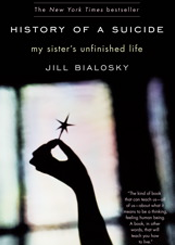Article
History of a Suicide: My Sister’s Unfinished Life
Author(s):
Mostly prose with effective inclusion of poetry, author Jill Bialosky adds an important survivor’s perspective in her book of her sister's suicide. To clinicians in particular, the book may serve as a window into the psychic lives of those left behind following a tragic end.
Mostly prose with effective inclusion of poetry, Jill Bialosky adds an important survivor’s perspective in her recent book History of a Suicide: My Sister’s Unfinished Life. Ms. Bialosky writes the story of her sister Kim’s suicide several times, much the way a patient in therapy may consider and reconsider a traumatic life event, each time doing so with a slightly different approach and emphasis.
In the opening chapter, we learn the factual events that immediately surround Kim’s suicide. From the factual account, the work moves to considerations of possible triggering events closely related in time to the suicide. Woven between these possible triggers are reflections on the young life of the suicide victim, the father who abandoned her and ultimately returned briefly only to tell Kim how much he disapproved of her, as well as the mother who spent much of her adult life searching for a partner while under the daily influence of benzodiazepines and alcohol.
In addition, the author’s quest to understand her sister’s death includes considerations of suicide in general. Towards this end, Ms Bialosky turns to poetry, literature, and first-person accounts of mental illness. She also seeks answers via a thorough review of the academic literature and personal interaction with leaders in the field. She recounts her cross-country trip to Los Angeles to meet with a pioneer in suicidology, the late Edwin Schneidman, where in addition to engaging in intellectual considerations of suicide, he conducts a “psychological autopsy” of Kim. There are visits to a suicide survivor support group from which the author hopes to gain an understanding of the event by listening to those who have experienced similar tragedies.
There are episodes in the book that will serve as reminder of the stark contrasts between what people ask from psychiatry and what the field can always deliver. At the time of her suicide, there is the business card of a psychiatrist in Kim’s purse. After research, the author finds that her sister sought treatment for her duress that was ultimately unsuccessful. (in a choice that is to be appreciated by psychiatrists, Ms Bialosky immediately informs the reader that her sister was not in contact with the psychiatrist for several months before her fatal event). After much effort and planning, the family is able to encourage Kim to go to the hospital for a psychiatric admission-but when Kim reverses her decision to be admitted, the psychiatrist stuns the family by informing them that she does not meet criteria for involuntary admission and sends her home with the family.
To clinicians in particular, the book may serve as a window into the psychic lives of those left behind following a suicide. Questions such as “what was really going through the suicidal person’s mind?” and “how could this have happened?” are likely being considered in a very high percentage of survivors.
Just as the author does not arrive at absolute answers, it will likely be the work of the psychiatrist who-in addition to treating any mental illness present-will have to help the survivor accept that some questions will never be satisfactorily answered.







